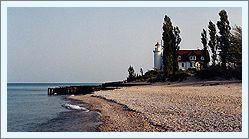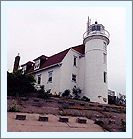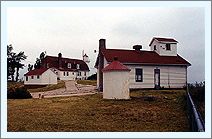|
Historical Information

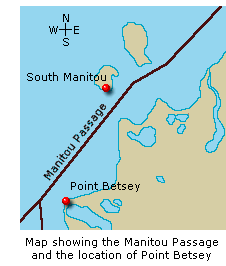 The fastest and most
protected course for vessels making their way north to the Straits from
the southern shores if Lake Michigan was through the natural channel
between the Manitou and Beaver islands and the mainland along Lake
Michigan's eastern shore, known as the Manitou Passage. To mark the western entry
to the passage, the
Fifth Auditor of the Treasury had established a lighthouse on the
southern tip of South
Manitou Island in 1840. However, by the early
1850's, no steps had been taken to mark the passage's eastern side. Assuming responsibility for the nation's aids to navigation in
1853, the
newly formed Lighthouse Board quickly sought to rectify this oversight.
Noting that vessels making for the passage used a
natural point on the mainland 20 miles southeast of South Manitou known as Point
Betsey as a marker to begin their northeasterly turn into the passage,
the lighthouse Board recommended that an appropriation of $5,000 be made
to fund the construction of a lighthouse on Point Betsey in its first
annual report to Congress. The fastest and most
protected course for vessels making their way north to the Straits from
the southern shores if Lake Michigan was through the natural channel
between the Manitou and Beaver islands and the mainland along Lake
Michigan's eastern shore, known as the Manitou Passage. To mark the western entry
to the passage, the
Fifth Auditor of the Treasury had established a lighthouse on the
southern tip of South
Manitou Island in 1840. However, by the early
1850's, no steps had been taken to mark the passage's eastern side. Assuming responsibility for the nation's aids to navigation in
1853, the
newly formed Lighthouse Board quickly sought to rectify this oversight.
Noting that vessels making for the passage used a
natural point on the mainland 20 miles southeast of South Manitou known as Point
Betsey as a marker to begin their northeasterly turn into the passage,
the lighthouse Board recommended that an appropriation of $5,000 be made
to fund the construction of a lighthouse on Point Betsey in its first
annual report to Congress.
Congress appropriated the requested
funds on March 3, 1853, and President Franklin Pierce ordered the
purchase of a ten acre reservation on the barren dunes on April 4 of
that same year. With the process of obtaining clear title to the land
underway, a contract was awarded for the station's construction, and
plans were put in place to begin construction on the opening of
navigation the following year. While the contractor was reported to be
on the site in 1854, for reasons yet to be determined, construction of
the station was not completed until 1858.
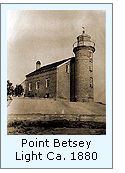 The plan for the Point Betsey Light
called for a cylindrical single-walled tower constructed of Cream City
brick, standing 37 feet in height from the foundation to the top of the
ventilator ball. Five concentric brick rings encircling the tower
beneath the lantern, each successively larger in diameter than the lower
ring, formed a support for the gallery on which an decagonal cast iron
lantern was installed. The lantern was outfitted with a white Fourth
Order Fresnel lens equipped with bulls eyes, which was rotated around
the lamp by a clockwork drive at a precisely monitored speed to impart
the station's characteristic fixed white light with a flash every 90
seconds. By virtue of the tower's location on the dune, the lens was
located at a focal plane of 52 feet above lake level with a range of
visibility of ten miles. The small two story dwelling, also of Cream
City brick was located on an excavated cellar immediately inshore of the
tower, to which it was connected by a short covered passageway. This
passageway was outfitted with a cast iron door at the tower end in order
to stop the spread of any possible fire between the two structures. The
exact date on which the Point Betsey Light was exhibited has been lost
to history. While Lighthouse Board annual reports and Light Lists report
the station as being completed in 1858, it was not until February 1,
1859 that David Flury, the first keeper to be assigned to the station,
appears in District payroll. Thus, it may well be that while
construction was completed in 1858, the Light was not activated until
the opening of the 1859 navigation season. The plan for the Point Betsey Light
called for a cylindrical single-walled tower constructed of Cream City
brick, standing 37 feet in height from the foundation to the top of the
ventilator ball. Five concentric brick rings encircling the tower
beneath the lantern, each successively larger in diameter than the lower
ring, formed a support for the gallery on which an decagonal cast iron
lantern was installed. The lantern was outfitted with a white Fourth
Order Fresnel lens equipped with bulls eyes, which was rotated around
the lamp by a clockwork drive at a precisely monitored speed to impart
the station's characteristic fixed white light with a flash every 90
seconds. By virtue of the tower's location on the dune, the lens was
located at a focal plane of 52 feet above lake level with a range of
visibility of ten miles. The small two story dwelling, also of Cream
City brick was located on an excavated cellar immediately inshore of the
tower, to which it was connected by a short covered passageway. This
passageway was outfitted with a cast iron door at the tower end in order
to stop the spread of any possible fire between the two structures. The
exact date on which the Point Betsey Light was exhibited has been lost
to history. While Lighthouse Board annual reports and Light Lists report
the station as being completed in 1858, it was not until February 1,
1859 that David Flury, the first keeper to be assigned to the station,
appears in District payroll. Thus, it may well be that while
construction was completed in 1858, the Light was not activated until
the opening of the 1859 navigation season.
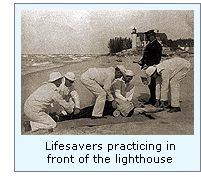 After only a year of operation, the
tower's location on the dune a scant few feet back from the waters edge
was found to be causing a problem that would plague the station
throughout the ensuing years. It was found that waves crashing against
the base of the dune were undermining the dune itself, and had displaced
some of the foundation stones on which the tower was erected, thereby
threatening the very stability of the tower itself. To stem the erosion,
in 1869 a timber protection was installed at the base of the dune, and
the foundation stones moved back into position and reinforced with
concrete. At this time, the dwelling roof was also replaced to stem
seepage which had caused large portions of plasterwork to fall and the
hardwood floors to buckle and decay. With a general expansion of the
service throughout the lakes, the Point Betsey Life Saving Station was
erected at a cost of $3,000 to the immediate south of the lighthouse
reservation in 1875 under the stewardship of Keeper Thomas Matthews. After only a year of operation, the
tower's location on the dune a scant few feet back from the waters edge
was found to be causing a problem that would plague the station
throughout the ensuing years. It was found that waves crashing against
the base of the dune were undermining the dune itself, and had displaced
some of the foundation stones on which the tower was erected, thereby
threatening the very stability of the tower itself. To stem the erosion,
in 1869 a timber protection was installed at the base of the dune, and
the foundation stones moved back into position and reinforced with
concrete. At this time, the dwelling roof was also replaced to stem
seepage which had caused large portions of plasterwork to fall and the
hardwood floors to buckle and decay. With a general expansion of the
service throughout the lakes, the Point Betsey Life Saving Station was
erected at a cost of $3,000 to the immediate south of the lighthouse
reservation in 1875 under the stewardship of Keeper Thomas Matthews.
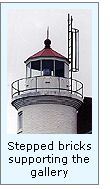 With an increasing volume of maritime
traffic making for the Straits from the growing cities on Lake
Michigan's southern shores, the Lighthouse Board recommended in its 1880
annual report to Congress that the sum of $40.000 be appropriated to
replace the diminutive tower and deteriorating dwelling with a structure
at least 100 feet in height, equipped with a Third Order Fresnel lens to
more effectively mark this critical southern turning point into the
Manitou Passage. While the Board would reiterate the request on an
annual basis over the following decade, Congress never allocated the
funds, and plans for the replacement were eventually abandoned, and the
District turned its focus to a less costly alternate solution to the
long term survival of the station. With an increasing volume of maritime
traffic making for the Straits from the growing cities on Lake
Michigan's southern shores, the Lighthouse Board recommended in its 1880
annual report to Congress that the sum of $40.000 be appropriated to
replace the diminutive tower and deteriorating dwelling with a structure
at least 100 feet in height, equipped with a Third Order Fresnel lens to
more effectively mark this critical southern turning point into the
Manitou Passage. While the Board would reiterate the request on an
annual basis over the following decade, Congress never allocated the
funds, and plans for the replacement were eventually abandoned, and the
District turned its focus to a less costly alternate solution to the
long term survival of the station.
To this end, Ninth District Engineer
Major William Ludlow ordered a thorough engineering inspection of the
station in 1889. While Ludlow found moisture in the tower as a result of
its single-walled construction, he found the tower brickwork itself to
be structurally sound. However, the condition of the tower foundation
was found to be in an extremely precarious condition due to its shallow
depth, and the continued undermining of the sand. To strengthen the
foundation, the tower was blocked, the surrounding sand removed, and a
tapered concrete ring sixteen feet in diameter at the base, twelve feet
in diameter at the top with an inside opening of four feet in diameter
was inserted in sections beneath the tower. The inner cavity of this
ring was then filled with cement up to the first floor level to lock the
foundation ring to the tower, and covered with a brick veneer to serve
as a durable floor within the tower. In an attempt to prevent further
foundation erosion, a contractor arrived at the station on April 17,
1890 and began driving timber pilings at the water's edge in order to
construct a curved revetment some 240 feet in length at the base of the
dune. The pile-driving was completed the following month, and the dune
above the revetment was covered with a facing of 3" by 12"
planks with 2" spaces between, and the entire structure filled with
crushed stone to both offer support to the revetment and to absorb the
energy of waves passing through the openings in the plank facing. From
the face of this revetment, two fifty foot long timber jetties, fourteen
feet in width and also filled with stone, protruded into the lake in
order to dissipate the energy of waves traveling diagonally across the
shoreline.
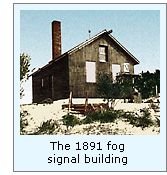 With the stabilization project
complete, the Lighthouse Board turned its attention to the periods of
thick weather which enveloped the point, requesting an appropriation of
$5,000 for the construction of a first class fog signal building at the
station in its annual report to Congress for fiscal 1890. Congress
appropriated the requested funds on March 31, 1891, and the Ninth
District office responded quickly, issuing a contract for the
fabrication of the machinery on June 23. Work at the station began soon
thereafter with the construction of a 22 foot by 40 foot fog signal
building approximately 120 feet to the north of the lighthouse. A
timber-framed building, its exterior was sheathed in corrugated iron,
and its interior walls covered with smooth iron sheets. On concrete
foundations within the building, the duplicate steam engines equipped
with 10-inch steam whistles were erected and supplied with water from a
brick curbed well dug beside the building. Work on the building was
completed, and the machinery tested successfully on December 22, and the
new signals placed into operation during a snowstorm on December 22,
1891. With the stabilization project
complete, the Lighthouse Board turned its attention to the periods of
thick weather which enveloped the point, requesting an appropriation of
$5,000 for the construction of a first class fog signal building at the
station in its annual report to Congress for fiscal 1890. Congress
appropriated the requested funds on March 31, 1891, and the Ninth
District office responded quickly, issuing a contract for the
fabrication of the machinery on June 23. Work at the station began soon
thereafter with the construction of a 22 foot by 40 foot fog signal
building approximately 120 feet to the north of the lighthouse. A
timber-framed building, its exterior was sheathed in corrugated iron,
and its interior walls covered with smooth iron sheets. On concrete
foundations within the building, the duplicate steam engines equipped
with 10-inch steam whistles were erected and supplied with water from a
brick curbed well dug beside the building. Work on the building was
completed, and the machinery tested successfully on December 22, and the
new signals placed into operation during a snowstorm on December 22,
1891.
With the increase in workload
represented by the fog signal, an the addition of an Assistant was
approved for the station. Charles W. Butler was appointed to the
position, moving into the small dwelling with Keeper Peter Dues and his
family on February 25, 1892. On April 23, Mr. Crump the District Lampist
arrived at the station and installed a new Fourth Order Fresnel lens,
changing the characteristic from fixed white varied by a white flash
every 90 seconds to flashing white every ten seconds. Also this year, a
work crew arrived at the station with the components of a prefabricated
circular cast iron oil storage building, which was erected a short
distance behind the fog signal building. The crew also poured a concrete
floor in the cellar, and installed 530 feet of plank walks from the
dwelling and around the fog signal building.
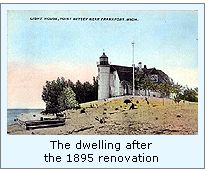 It soon became clear that the small
dwelling was insufficient for two families, and in 1895 a work crew
arrived at the station to undertake a complete renovation and
enlargement of the structure. In order to convert the structure into a
duplex dwelling, the building was enlarged in both width and length
through the addition of six rooms and a rear addition, and the hip roof
replaced by one of gambrel design. Also at this time, the station barn
was completely rebuilt and the fog signal machinery overhauled. 1895 was
also memorable for Head Keeper Soren Christianson and Assistant Medad
Spencer, for in this year they were kept busy feeding the hungry boilers
to keep the fog signal actively screaming for a station high 1,312
hours. Doubtless Christianson looked forward to the relative peace and
quiet of Chambers Island when he accepted a transfer to that station at
the end of the season on November 13. It soon became clear that the small
dwelling was insufficient for two families, and in 1895 a work crew
arrived at the station to undertake a complete renovation and
enlargement of the structure. In order to convert the structure into a
duplex dwelling, the building was enlarged in both width and length
through the addition of six rooms and a rear addition, and the hip roof
replaced by one of gambrel design. Also at this time, the station barn
was completely rebuilt and the fog signal machinery overhauled. 1895 was
also memorable for Head Keeper Soren Christianson and Assistant Medad
Spencer, for in this year they were kept busy feeding the hungry boilers
to keep the fog signal actively screaming for a station high 1,312
hours. Doubtless Christianson looked forward to the relative peace and
quiet of Chambers Island when he accepted a transfer to that station at
the end of the season on November 13.
In order to make the structures more
visible against the dunes and trees during daylight hours, and thus
serve more effectively as a daymark to mariners offshore, both the tower
and dwelling were painted white, and the roofs painted bright red in
1900. With the turn of the century, for some reason the spelling of the
name of the area changed to "Point Betsie," with the name of
the station being spelled in that manner for the first time in the
Lighthouse Board annual reports for fiscal 1902. The keepers settled
into a relatively uneventful decade, with no major construction or
renovation projects undertaken on the Point. This relative peace was
interrupted in the fall of 1912, when a work crew arrived on the point
to completely rebuild the fog signal building and to replace the 10-inch
locomotive whistles with 10-inch chime whistles, which were placed into
operation on October 1. On October 1 of the following year the lamp was
upgraded to an incandescent oil vapor system, with a resulting increase
in intensity to 55,000 candlepower.
With the extension of electric power
lines into the area in 1921, arrangements were made to hook the station
into the power grid, and a 110-volt electric bulb was installed in the
lens, and the fog signal again upgraded to twin Type "G"
diaphones, powered by a pair of electrically driven air compressors. The
Type "G" diaphone represented a significant improvement,
since their audible radius was almost double that of previous systems,
and their electric power allowed them to be sounded almost immediately
when needed, as opposed to waiting for the steam engines to build
sufficient pressure to operate. To better take advantage of the inherent
capabilities of the diaphone, the fog signal's characteristic was
changed on April 1 of the following year to a group of two blasts every
30 seconds.
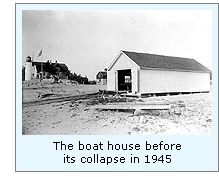 With the dissolution of the Lighthouse
Service in 1939, and responsibility for the nation's aids to navigation
transferred to the Coast Guard, in order to decrease operating costs a
renewed emphasis was placed on automation and the reduction of staffing
levels. To this end, the position of Second Assistant was eliminated at
Point Betsie, with Nels A. Nelson being the last man to serve in the
position on his retirement from service in 1940. Around this time, the
station boathouse collapsed, leaving nothing but the stone foundation
remaining on the shore. The lens clockwork was removed from the tower in
1944, and an electric motor installed to rotate the venerable Fresnel
lens. No longer serving any Government purpose, the remaining Point
Betsey Life Saving Station buildings was sold into private ownership in
1945. With the dissolution of the Lighthouse
Service in 1939, and responsibility for the nation's aids to navigation
transferred to the Coast Guard, in order to decrease operating costs a
renewed emphasis was placed on automation and the reduction of staffing
levels. To this end, the position of Second Assistant was eliminated at
Point Betsie, with Nels A. Nelson being the last man to serve in the
position on his retirement from service in 1940. Around this time, the
station boathouse collapsed, leaving nothing but the stone foundation
remaining on the shore. The lens clockwork was removed from the tower in
1944, and an electric motor installed to rotate the venerable Fresnel
lens. No longer serving any Government purpose, the remaining Point
Betsey Life Saving Station buildings was sold into private ownership in
1945.
In 1952, the station's First Assistant
Keeper Louis S. Bauchan retired from lighthouse service. Born in 1912,
Louis entered lighthouse service in 1936, serving at Chicago Harbor,
Pilot Island, St. Martin Island and
Poverty Island before transferring
to Betsie in 1947. Thus, Louis was the last of the old Lighthouse
Service civilian "Wickies" to serve at Point Betsie, and with
his departure a historic era came to a close. While automation had
virtually eliminated the need for keepers at Point Betsie, the dwelling
continued to see use as housing for seamen stationed at Coast Guard
Station Frankfort, and with the building thus occupied, the final steps
to automation were not taken until 1984, when the station took the honor
of being the last light station on the Great Lakes to be completely
automated.
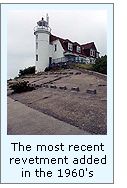 The Fourth Order lens, which had served
at the station for 104 years was removed from the tower in 1996 and
replaced with a Vega VRB-25 250 mm acrylic optic. The old lens was
carefully moved to the Sleeping Bear National Lakeshore Park
headquarters building, where it was placed on display and where it may
be seen to this day. The Coast Guard relocated the final personnel from
the lighthouse to Station Frankfort in 1996, and after 138 years of faithful service to
mariners, the Point Betsie Light was locked-up and left to face the
elements alone. The Fourth Order lens, which had served
at the station for 104 years was removed from the tower in 1996 and
replaced with a Vega VRB-25 250 mm acrylic optic. The old lens was
carefully moved to the Sleeping Bear National Lakeshore Park
headquarters building, where it was placed on display and where it may
be seen to this day. The Coast Guard relocated the final personnel from
the lighthouse to Station Frankfort in 1996, and after 138 years of faithful service to
mariners, the Point Betsie Light was locked-up and left to face the
elements alone.
The
Ninth District Office in Cleveland officially considered the property as
"excess" and turned the station over to the Bureau of Land
Management for liquidation. The station was transferred to Benzie County
through the auspices of the National Historic Lighthouse Preservation
Act in 2004. The grass-roots group
Friends of Point Betsie Lighthouse
immediately embarked on a complete restoration of the station.

Keepers of this
Light

Click Here to see a complete listing of all Point Betsie Light keepers
compiled by Phyllis L. Tag of Great Lakes Lighthouse Research.

Contact
information

For information on the restoration effort, hours the station is open to
the public, or to make a donation to the
cause, contact:
The Friends of Point Betsie Lighthouse
P.O. Box 601
Frankfort, MI49635-0601
Telephone: (231) 352-4915
Email: info@pointbetsie.org

Finding this
Light

Take M22 North around Crystal Lake, which you will see on the East side
of the road. Approximately 5 1/2 miles North of the junction of
M22 and M115, Point Betsie Rd. intersects from the West. Turn onto Point
Betsie Rd. and drive approximately 1 mile to the lakeshore. The road
widens at the beach, and affords a few parking spaces. The Lighthouse is
on the North side of the road.

Reference
Sources

Annual report of the Fifth Auditor of the Treasury - 1852
Annual reports of the Lighthouse Board, various, 1853-1909
Annual reports of the Lighthouse
Service, 1910 - 1939
Thompson's Coast Pilot, 1869
Great Lakes Light Lists, Various, 1861 -
1998
Annual reports of the Lake Carrier's Association, Various, 1912 -
1924
Great Lakes Coast Pilot, Corps of Engineers, 1958
Traverse City Record Eagle, articles, 04/26/02, 05/06/02 &
06/12/02
Grand Rapids Press, article 03/16/00
Personal observation at Point Betsie, 09/13/98 & 07/15/00
Historic image from USCG Historians office, Photographic archives.
Keeper listings for this light appear courtesy of Great
Lakes Lighthouse Research
|
